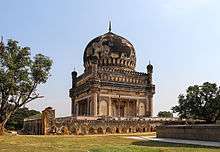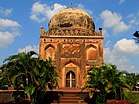Deccan sultanates
The Deccan sultanates were five late-medieval Indian kingdoms—on the Deccan Plateau between the Krishna River and the Vindhya Range—that were ruled by Muslim dynasties: namely Ahmadnagar, Berar, Bidar, Bijapur, and Golconda.[1] The sultanates had become independent during the break-up of the Bahmani Sultanate.[2][3] In 1490, Ahmadnagar declared independence, followed by Bijapur and Berar in the same year. Golconda became independent in 1518, and Bidar in 1528.[4]
Deccan sultanates | |||||||||||
|---|---|---|---|---|---|---|---|---|---|---|---|
| 1527 CE–1686 CE | |||||||||||
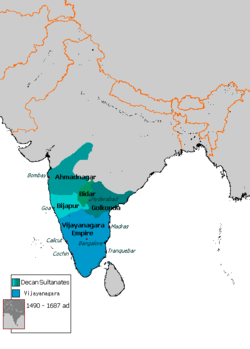 Map of the Deccan sultanates. | |||||||||||
| Capital | Ahmednagar Bidar Bijapur Ellichpur Golconda Hyderabad | ||||||||||
| Common languages | Persian (official) Deccani Urdu Marathi Kannada Telugu | ||||||||||
| Religion | Islam | ||||||||||
| Government | Monarchy | ||||||||||
| Shah | |||||||||||
| Historical era | Late Medieval | ||||||||||
• Established | 1527 CE | ||||||||||
• Disestablished | 1686 CE | ||||||||||
| Currency | Taka | ||||||||||
| |||||||||||
| Today part of | India | ||||||||||
| Outline of South Asian history | ||||||||||||||||||||||||||||||||||||||||||||
|---|---|---|---|---|---|---|---|---|---|---|---|---|---|---|---|---|---|---|---|---|---|---|---|---|---|---|---|---|---|---|---|---|---|---|---|---|---|---|---|---|---|---|---|---|
_without_national_boundaries.svg.png) | ||||||||||||||||||||||||||||||||||||||||||||
|
Palaeolithic (2,500,000–250,000 BC) |
||||||||||||||||||||||||||||||||||||||||||||
|
Neolithic (10,800–3300 BC)
|
||||||||||||||||||||||||||||||||||||||||||||
|
Chalcolithic (3500–1500 BC)
|
||||||||||||||||||||||||||||||||||||||||||||
|
Bronze Age (3300–1300 BC)
|
||||||||||||||||||||||||||||||||||||||||||||
|
Iron Age (1500–200 BC)
|
||||||||||||||||||||||||||||||||||||||||||||
|
Middle Kingdoms (230 BC – AD 1206) |
||||||||||||||||||||||||||||||||||||||||||||
|
Late medieval period (1206–1526)
|
||||||||||||||||||||||||||||||||||||||||||||
|
Early modern period (1526–1858)
|
||||||||||||||||||||||||||||||||||||||||||||
|
Colonial states (1510–1961)
|
||||||||||||||||||||||||||||||||||||||||||||
|
Periods of Sri Lanka
|
||||||||||||||||||||||||||||||||||||||||||||
|
Specialised histories |
||||||||||||||||||||||||||||||||||||||||||||
The five sultanates were of diverse origin: the Ahmadnagar Sultanate was Brahmin-Hindu; the Berar Sultanate was Kanarese-Hindu;[5] the Bidar Sultanate was founded by a former Turkic slave;[6] the Bijapur Sultanate was founded by a Georgian-Oghuz Turkic slave;[7] and the Golconda Sultanate was of Turkmen origin.[8]
Although generally rivals, the sultanates did ally with each other against the Vijayanagara Empire in 1565, permanently weakening Vijayanagara in the Battle of Talikota. Notably, the alliance destroyed the entire city of Vijayanagara, with important temples such as the Vitthala Temple, being razed to the ground.
In 1574, after a coup in Berar, Ahmadnagar invaded and conquered it. In 1619, Bidar was annexed by Bijapur. The sultanates were later conquered by the Mughal Empire: Berar was stripped from Ahmadnagar in 1596; Ahmadnagar was completely taken between 1616 and 1636; and Golconda and Bijapur were conquered by Aurangzeb's 1686–87 campaign.[9]
Ahmadnagar Sultanate

The Ahmadnagar Sultanate was founded by Malik Ahmad Nizam Shah I, who was the son of Nizam-ul-Mulk Malik Hasan Bahri.[5]:189 Malik Ahmad Nizam Shah I was the governor of Junnar.[1] After defeating the Bahmani army led by general Jahangir Khan on May 28, 1490, he declared independence and established dynastic rule over Ahmadnagar. The territory of the sultanate was located in the northwestern Deccan, between the sultanates of Gujarat and Bijapur. Initially, his capital was in Junnar. In 1494, the foundation was laid for the new capital of Ahmadnagar. Malik Ahmed Shah, after several attempts, secured the fortress of Daulatabad in 1499.
After Malik Ahmed Shah's death in 1510, his son Burhan, a boy of seven, was installed in his place. Burhan Shah I died in Ahmadnagar in 1553. He left six sons, of whom Hussain succeeded him. After the death of Hussain Shah I in 1565, his son Murtaza (a minor) ascended the throne. While Murtaza was a child, his mother, Khanzada Humayun Sultana, ruled as a regent for several years. Murtaza Shah annexed Berar in 1574. On his death in 1588, his son Miran Hussain ascended the throne; but his reign lasted only a little more than ten months, as he was poisoned. Ismail, a cousin of Miran Hussain was raised to the throne, but the actual power was in the hands of Jamal Khan, the leader of the Deccani group in the court. Jamal Khan was killed in the battle of Rohankhed in 1591; and soon Ismail Shah was also captured and confined by his father Burhan, who ascended the throne as Burhan Shah. After the death of Burhan Shah, his eldest son Ibrahim ascended the throne. Ibrahim Shah died only after a few months in a battle with the Bijapur Sultanate. Soon, Chand Bibi, the aunt of Ibrahim Shah, proclaimed Bahadur, the infant son of Ibrahim Shah, as the rightful Sultan; and she became regent. In 1596, a Mughal attack led by Murad was repulsed by Chand Bibi.
After the death of Chand Bibi in July 1600, Ahmadnagar was conquered by the Mughals, and Bahadur Shah was imprisoned. But Malik Ambar, and other Ahmadnagar officials, defied the Mughals and declared Murtaza Shah II as sultan in 1600 at a new capital, Paranda. Malik Ambar became prime minister and Vakil-us-Saltanat of Ahmadnagar.[10] Later, the capital was shifted first to Junnar and then to a new city Khadki (later Aurangabad). After the death of Malik Ambar, his son Fath Khan surrendered to the Mughals in 1633 and handed over the young Nizam Shahi ruler Hussain Shah, who was sent as a prisoner to the fort of Gwalior. But soon Shahaji with the assistance of Bijapur, placed an infant scion of the Nizam Shahi dynasty, Murtaza, on the throne but acted as regent. In 1636, Aurangzeb, the Mughal viceroy of Deccan, finally annexed the sultanate to the Mughal empire, after defeating Shahaji.
Rulers
- Malik Ahmad Nizam Shah I (1490–1510)
- Burhan Nizam Shah I (1510–1553)
- Hussain Nizam Shah I (1553–1565)
- Murtaza Nizam Shah I (1565–1588)
- Miran Nizam Hussain (1588–1589)
- Isma'il Nizam Shah (1589–1591)
- Burhan Nizam Shah II (1591–1595)
- Ibrahim Nizam Shah (1595–1596)
- Ahmad Nizam Shah II (1596)
- Bahadur Nizam Shah (1596–1600)
- Murtaza Nizam Shah II (1600–1610)
- Burhan Nizam Shah III (1610–1631)
- Hussain Nizam Shah II (1631–1633)
- Murtaza Nizam Shah III (1633–1636).[11]
Berar Sultanate
The Berar Sultanate was founded by Fathullah Imad-ul-Mulk, who was born a Kannadiga Hindu, but was captured as a boy by Bahmani forces, which were on an expedition against the Vijayanagara empire, and reared as a Muslim.[5] In 1490, during the disintegration of the Bahmani Sultanate, Imad-ul-Mulk, then governor of Berar, declared independence and founded the Imad Shahi dynasty of the Berar Sultanate. He established the capital at Achalpur (Ellichpur), and Gavilgad and Narnala were also fortified by him.
Upon his death in 1504, Imad-ul-Mulk was succeeded by his eldest son, Ala-ud-din. In 1528, Ala-ud-din resisted the aggression of Ahmadnagar with help from Bahadur Shah, Sultan of Gujarat. The next ruler of Berar, Darya, first tried to ally with Bijapur, to prevent the aggression of Ahmadnagar, but was unsuccessful. Later, he helped Ahmednagar on three occasions against Bijapur. After his death in 1562, his infant son Burhan succeeded him; but in 1574 Tufal Khan, one of Burhan's ministers, usurped the throne. In the same year, Murtaza I, Sultan of Ahmadnagar, annexed Berar to his sultanate. Burhan, Tufal Khan, and Khan's son Shamshir-ul-Mulk, were taken to Ahmadnagar and confined to a fortress where all of them subsequently died.[12]
Rulers
- Fathullah Imad-ul-Mulk (1490–1504)
- Ala-ud-din Imad Shah (1504–1530)
- Darya Imad Shah (1530–1562)
- Burhan Imad Shah (1562–1574)
- Tufal Khan (usurper) (1574)[12]
Bidar Sultanate
Bidar was the smallest of the five Deccan sultanates. Qasim Barid, founder of the Barid Shahi dynasty, joined the service of Bahmani ruler Mahmud Shah Bahmani (r. 1482–1518) as a sar-naubat (commander), and later became a mir-jumla (governor) of the Bahmani Sultanate. In 1492, he became de facto ruler of Bahmani, although Sultan Mahmud Shah Bahmani remained as the nominal ruler.
After Mahmud Shah Bahmani's death in 1504, his son Amir Barid controlled the administration of the Bahmani Sultanate. In 1528, with the flight of the last Bahmani ruler, Kalimullah, from Bidar, Amir Barid became practically an independent ruler. Amir Barid was succeeded by his son Ali Barid, who was the first to assume the title of shah. Ali Barid participated in the Battle of Talikota and was fond of poetry and calligraphy.
The last ruler of the Bidar Sultanate, Amir Barid Shah III, was defeated in 1619, and the sultanate was annexed to the Bijapur Sultanate.[13]
Rulers
- Qasim Barid I (1492–1504)
- Amir Barid I (1504–1542)
- Ali Barid Shah (1542–1580)
- Ibrahim Barid Shah (1580–1587)
- Qasim Barid Shah II (1587–1591)
- Ali Barid Shah II (1591)
- Amir Barid Shah II (1591–1600)
- Mirza Ali Barid Shah III (1600–1609)
- Amir Barid Shah III (1609–1619)[11]
Bijapur Sultanate
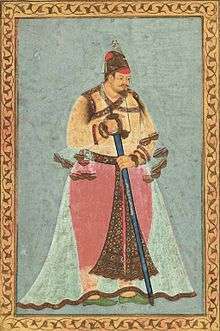
Located in southwestern India, straddling the Western Ghats range of southern Maharashtra and northern Karnataka, the Bijapur Sultanate was ruled by the Adil Shahi dynasty from 1490 to 1686. The Adil Shahis were originally provincial governors of the Bahmani Sultanate; but with the break-up of the Bahmani state after 1518, Ismail Adil Shah established an independent sultanate. Ismail Adil Shah and his successors embellished the capital at Bijapur with numerous monuments.
The Adil Shahis fought the Vijayanagara Empire, which lay to the south, across the Tungabhadra River, but fought the other Deccan sultanates as well. However, the five sultanates combined forces to decisively defeat Vijayanagar at the Battle of Talikota in 1565, after which the empire broke up, Bijapur seizing control of the Raichur Doab. In 1619, the Adil Shahis conquered the neighbouring sultanate of Bidar, which was incorporated into their realm.
Later in the 17th century, the Marathas revolted successfully under Shivaji's leadership, captured major parts of the sultanate, and its capital, Bijapur. The weakened sultanate was conquered by Aurangzeb in 1686 with the fall of Bijapur, bringing the dynasty to an end.
Rulers
- Yusuf Adil Shah (1490–1510)
- Ismail Adil Shah (1510–1534)
- Mallu Adil Shah (1534–1535)
- Ibrahim Adil Shah I (1535–1558)
- Ali Adil Shah I (1558–1580)
- Ibrahim Adil Shah II (1580–1627)
- Mohammed Adil Shah (1627–1656)
- Ali Adil Shah II (1656–1672)
- Sikandar Adil Shah (1672–1686)[11]
Golconda Sultanate
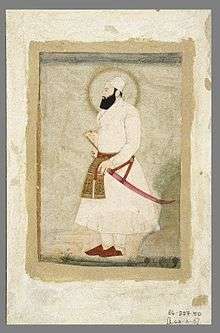
The dynasty's founder, Sultan Quli Qutb-ul-Mulk, migrated to Delhi from Persia with some of his relatives and friends in the beginning of the 16th century. Later he migrated south to the Deccan and served the Bahmani Sultan Mohammed Shah I. Quli Qutb-ul-Mulk conquered Golconda and became the governor of the Telangana region in 1518, after the disintegration of the Bahmani sultanate. Soon after, he declared his independence and took the title of Qutb Shah.
The dynasty ruled for 171 years, until the Mughal emperor Aurangzeb's army besieged and conquered Golconda in 1687.
Rulers
- Sultan Quli Qutb-ul-Mulk (1518–1543)
- Jamsheed Quli Qutb Shah 1543–1550
- Subhan Quli Qutb Shah (1550)
- Ibrahim Quli Qutub Shah (1550–1580)
- Muhammad Quli Qutb Shah (1580–1611)
- Sultan Muhammad Qutb Shah (1611–1626)
- Abdullah Qutb Shah (1626–1672)
- Abul Hasan Qutb Shah (1672–1687)[14]
Decline
Cultural contributions
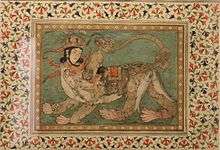
The rulers of the Deccan sultanates made a number of cultural contributions in the fields of literature, art, architecture, and music.
An important contribution was the development of the Dakhani language, which, having started development under the Bahamani rulers, developed into an independent spoken and literary language during this period by continuously borrowing from Arabic-Persian, Marathi, Kannada, and Telugu. Dakhani later became known as Dakhani Urdu to distinguish it from North Indian Urdu.
Deccani miniature painting—which flourished in the courts of Ahmadnagar, Bijapur, and Golconda—is another major cultural contribution of the Deccan sultanates.[17]
Architectural splendors of Deccan such as Charminar and Gol Gumbaz belong to this period. The religious tolerance displayed by the Nizam Shahi, Adil Shahi, and Qutb Shahi rulers is also worthy of mention.
Ahmadnagar
The Nizam Shahi rulers of Ahmadnagar enthusiastically patronised miniature painting, the earliest surviving of which are found as the illustrations of the manuscript Tarif-i-Hussain Shahi (c.1565), which is now in the Bharat Itihas Sanshodhak Mandal, Pune. A miniature painting of Murtaza Nizam Shah (c.1575) is in the Bibliothèque Nationale of Paris, while another one is in the Raza Library in Rampur. The Running Elephant is in an American private collection, the Royal Picnic is in the India Office Library in London, and the Young Prince Embraced by a Small Girl, most likely belonging to the Burhan Nizam Shah II period, is in the Edwin Binney 3rd Collection of South Asian Works in the San Diego Museum of Art.[18]
The earliest notable architecture of the Nizam Shahi rulers of Ahmadnagar is the tomb of Ahmad Shah I Bahri (1509), at the centre of Bagh Rouza, a garden complex.[19] The Jami Masjid also belongs to the same period. The Mecca Masjid, built in 1525 by Rumi Khan, a Turkish artillery officer of Burhan Nizam Shah I, is original in its design. The Kotla complex was constructed in 1537 as a religious educational institution. The impressive Farah Bagh was the centrepiece of a large palatial complex completed in 1583. Other monuments in Ahmednagar of the Nizam Shahi period are the Do Boti Chira (tomb of Sharja Khan, 1562), Damri Masjid (1568), and the tomb of Rumi Khan (1568). The Jami Masjid (1615) in Khirki (Aurangabad) and the Chini Mahal inside the Daulatabad fort were constructed during the late Nizam Shahi period (1600–1636). The tomb of Malik Ambar in Khuldabad (1626) is another impressive monument of this period. The Kali Masjid of Jalna (1578) and the tomb of Dilawar Khan (1613) in Rajgurunagar also belong to this period.[20][21]
During the reign of Ahmad Shah I Bahri, his keeper of imperial records, Dalapati, wrote an encyclopedic work, the Nrisimha Prasada, where he mentioned his overlord as Nizamsaha. It is a notable instance of the religious tolerance of the Nizam Shahi rulers.[22]
Berar
The ruined palace of Hauz Katora, 3 kilometres (1.9 mi) west of Achalpur, is the only notable surviving Imad Shahi monument.[23]
Bidar
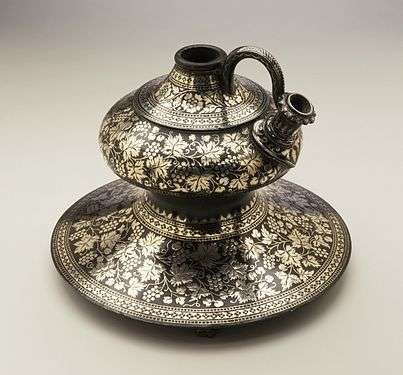
The main architectural activities for the Barid Shahi rulers were building garden tombs. The tomb of Ali Barid Shah (1577) is the most notable monument in Bidar.[24] The tomb consists of a lofty domed chamber, open on four sides, located in the middle of a Persian four-square garden. The Rangin Mahal in Bidar, built during the reign of Ali Barid Shah, is a complete and exquisitely decorated courtly structure. Other important monuments in Bidar from this period are the tomb of Qasim II and the Kali Masjid.[25]
An important class of metalwork known as Bidriware originated in Bidar. This metalwork consists of a black metal, usually a zinc alloy, inlaid with intricate designs in silver, brass, and sometimes copper.[26]
Bijapur

The Adil Shahi rulers contributed greatly to architecture, art, literature, and music, as Bijapur developed into a cosmopolitan city under their rule and attracted many scholars, artists, musicians, and Sufi saints from Rome, Iran, Iraq, Turkey, and Turkestan. The Adil Shahi kings were known for their tolerance towards Hindus and non-interference in their religious matters. They employed Hindus to high posts, especially as officers overseeing accounts and administration, whose documents were maintained in Marathi.
Amongst the major architectural works in the Bijapur Sultanate, one of the earliest is the unfinished Jami Masjid, which was begun by Ali Adil Shah I in 1576. It has an arcaded prayer hall, with fine aisles, and has an impressive dome supported by massive piers. One of the most impressive monuments built during the reign of Ibrahim II was the Ibrahim Rouza which was originally planned as a tomb for queen Taj Sultana, but was later converted into the tomb for Ibrahim Adil Shah II and his family. This complex, completed in 1626, consists of a paired tomb and mosque. Ibrahim II also planned to construct a new twin city to Bijapur, Nauraspur, whose construction began in 1599 but was never completed. The greatest monument in Bijapur is the Gol Gumbaz, the mausoleum of Muhammad Adil Shah, which was completed in 1656, and whose hemispherical dome measures 44 metres (144 ft) across. The other important architectural works from this period are the Chini Mahal, the Jal Mandir, the Sat Manzil, the Gagan Mahal, the Anand Mahal, and the Asar Mahal (1646), all in Bijapur, as well as the Kummatgi (16 kilometres (9.9 mi) from Bijapur), the Panhala Fort (20 kilometres (12 mi) from Kolhapur), and Naldurg Fort (45 kilometres (28 mi) from Solapur).[27]
Persian artists of the Adil Shahi court have left a rare treasure of miniature paintings, some of which are well preserved in Europe's museums. The earliest miniature paintings are ascribed to the period of Ali Adil Shah I. The most significant of them are the paintings in the manuscript of Nujum-ul-Ulum (Stars of Science) (1570), kept in the Chester Beatty Library in Dublin, which contains about 400 miniature paintings. Two other illustrated manuscripts from the period of Ali Adil Shah I are Jawahir-al Musiqat-i-Muhammadi in the British Library, which contains 48 paintings, and a Marathi commentary of Sarangadeva's Sangita Ratnakara kept in the museum of City Palace, Jaipur, which contains 4 paintings. But the most miniature paintings come from the time of Sultan Ibrahim Adil Shah II. One of the most celebrated painters of his court was Maulana Farrukh Hussain. The miniature paintings of this period are preserved in the Bikaner Palace, the Bodleian Library in Oxford, the British Museum and Victoria and Albert Museum in London, the Muśee Guimet in Paris, the Academy of Sciences in St. Petersberg, and the Náprstek Museum in Prague.[28]
Under the Adil Shahi rulers many literary works were published in Dakhani. Ibrahim Adil Shah II himself wrote a book of songs, Kitab-i-Nauras, in Dakhani. This book contains a number of songs whose tunes are set to different ragas and raginis. In his songs, he praised the Hindu goddess Sarasvati along with the Prophet and Sufi saint Hazrat Khwaja Banda Nawaz Gesudaraz. A unique tambur (lute) known as Moti Khan was in his possession. The famous Persian poet laureate Muhammad Zuhuri was his court poet. The Mushaira (poetic symposium) was born in the Bijapur court and later travelled north.
Golconda
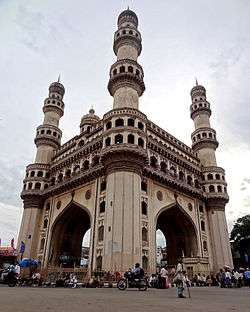
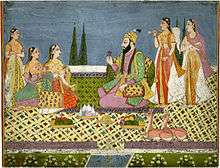
Qutb Shahi rulers appointed Hindus in important administrative posts. Ibrahim Quli Qutb Shah appointed Murari Rao as Peshwa, second to only Mir Jumla (prime minister).
One of the earliest architectural achievements of the Qutb Shahi dynasty is the fortified city of Golconda, which is now in ruins. The nearby Qutb Shahi tombs are also noteworthy.[15] In the 16th century, Muhammad Quli Qutb Shah decided to shift the capital to Hyderabad, 8 kilometres (5.0 mi) east of Golconda. Here, he constructed the most original monument in the Deccan, the Charminar, in the heart of the new city.[15] This monument, completed in 1591, has four minarets, each 56 metres (184 ft). The construction of the Mecca Masjid, located immediately south of the Charminar, was started in 1617, during the reign of Muhammad Qutb Shah, but completed only in 1693. The other important monuments of this period are the Toli Masjid, Shaikpet Sarai, Khairtabad Mosque, Taramati Baradari, Hayat Bakshi Mosque, and the Jama Masjid at Gandikota.[29]
The Qutb Shahi rulers invited many Persian artists, such as Shaykh Abbasi and Muhammad Zaman, to their court, whose art made a profound impact on the miniature paintings of this period. The earliest miniature paintings were the 126 illustrations in the manuscript of Anwar-i-Suhayli (c. 1550–1560) in the Victoria and Albert Museum. The illustrations Sindbad Namah in the India Office Library and Shirin and Khusrau in the Khudabaksh Library in Patna most probably belong to the reign of Ibrahim Quli Qutb Shah. The 5 illustrations in a manuscript of the Diwan-i-Hafiz (c.1630) in the British Museum, London, belong to the reign of Abdullah Qutb Shah. The most outstanding surviving Golconda painting probably is the Procession of Sultan Abdullah Qutb Shah Riding an Elephant (c. 1650) in the Saltykov-Shtshedrine State Public Library in St. Petersberg.[30] Their painting style lasted even after the dynasty was extinct and evolved into the Hyderabad style.
The Qutb Shahi rulers were great patrons of literature and invited many scholars, poets, historians and Sufi saints from Iran to settle in their sultanate. The sultans patronized literature in Persian as well as Telugu, the local language. However, the most important contribution of the Golconda Sultanate in the field of literature is the development of the Dakhani language. Muhammad Quli Qutb Shah was not only a great patron of art and literature but also a poet of a high order. He wrote in Dakhani, Persian, and Telugu and left an extensive Diwan (collection of poetry) in Dakhani, known as Kulliyat-i-Muhammad Quli Qutb Shah. Apart from the praise of God and the Prophet, he also wrote on nature, love and contemporary social life. Kshetrayya and Bhadrachala Ramadasu are some notable Telugu poets of this period.[31]
The Qutb Shahi rulers were much more liberal than their other Muslim counterparts. During the reign of Abdullah Qutb Shah, in 1634, the ancient Indian sex manual Koka Shastra was translated into Persian and named Lazzat-un-Nisa (Flavors of the Woman).[32]
See also
- Muslim conquest in the Indian subcontinent
Citations
- Sohoni, Pushkar (2018). The Architecture of a Deccan Sultanate: Courtly Practice and Royal Authority in Late Medieval India. London: I.B. Tauris. ISBN 9781784537944.
- Majumdar, R.C. (ed.) (2006). The Delhi Sultanate, Mumbai: Bharatiya Vidya Bhavan, p.269
- Sen, Sailendra (2013). A Textbook of Medieval Indian History. Primus Books. pp. 117–119. ISBN 978-9-38060-734-4.
- Majumdar, R.C. (ed.) (2007). The Mughul Empire, Mumbai: Bharatiya Vidya Bhavan, ISBN 81-7276-407-1, p.412
- Ferishta, Mahomed Kasim (1829). History of the Rise of the Mahometan Power in India, till the year A.D. 1612 Volume III. Translated by Briggs, John. London: Longman, Rees, Orme, Brown and Green.
- Bosworth 1996, p. 324.
- Chaurasia, Radhey Shyam (2002). History of Medieval India: From 1000 A.D. to 1707 A.D. p. 101.
- Ahmed, Farooqui Salma (2011). A Comprehensive History of Medieval India: Twelfth to the Mid-Eighteenth Century. p. 177.
- "500 years of Deccan history fading away due to neglect".
- Majumdar, R.C. (ed.)(2007). The Mughul Empire, Mumbai: Bharatiya Vidya Bhavan, ISBN 81-7276-407-1, pp.415–45
- Michell, George & Mark Zebrowski. Architecture and Art of the Deccan Sultanates (The New Cambridge History of India Vol. I:7), Cambridge University Press, Cambridge, 1999, ISBN 0-521-56321-6, p.274
- Majumdar, R.C. (ed.) (2007). The Mughul Empire, Mumbai: Bharatiya Vidya Bhavan, ISBN 81-7276-407-1, pp.463–6
- Majumdar, R.C. (ed.) (2007). The Mughul Empire, Mumbai: Bharatiya Vidya Bhavan, ISBN 81-7276-407-1, pp.466–8
- Michell, George & Mark Zebrowski. Architecture and Art of the Deccan Sultanates (The New Cambridge History of India Vol. I:7), Cambridge University Press, Cambridge, 1999, ISBN 0-521-56321-6, p.275
- Centre, UNESCO World Heritage. "The Qutb Shahi Monuments of Hyderabad Golconda Fort, Qutb Shahi Tombs, Charminar – UNESCO World Heritage Centre". whc.unesco.org. Archived from the original on 1 February 2018. Retrieved 28 September 2018.
- "Nauras: The Many Arts of the Deccan". Google Arts & Culture. Retrieved 27 January 2019.
- "Deccani painting". Encyclopedia Britannica. Retrieved 27 January 2019.
- Michell, George & Mark Zebrowski. Architecture and Art of the Deccan sultanates (The New Cambridge History of India Vol. I:7), Cambridge University Press, Cambridge, 1999, ISBN 0-521-56321-6, pp.145–151.
- Sohoni, Pushkar (2018). The Architecture of a Deccan Sultanate: Courtly Practice and Royal Authority in Late Medieval India (1. ed.). London: I.B.Tauris. ISBN 9781838609276.
- Sohoni, Pushkar (2010). "Local Idioms and Global Designs: Architecture of the Nizam Shahs" (Doctoral dissertation, University of Pennsylvania).
- Michell, George & Mark Zebrowski. Architecture and Art of the Deccan sultanates (The New Cambridge History of India Vol. I:7), Cambridge University Press, Cambridge, 1999, ISBN 0-521-56321-6, pp.80–86.
- Bhattacharya, D.C. (1962). The Nibandhas in S. Radhakrishnan (ed.) The Cultural Heritage in India, Vol.II, Calcutta: The Ramakrishna Mission Institute of Culture, ISBN 81-85843-03-1, p.378
- Michell, George & Mark Zebrowski. Architecture and Art of the Deccan sultanates (The New Cambridge History of India Vol. I:7), Cambridge University Press, Cambridge, 1999, ISBN 0-521-56321-6, p. 41.
- Yazdani 1947, pp. 152.
- George & Zebrowski 1999, pp. 14 & pp.77–80.
- Michell, George & Mark Zebrowski. Architecture and Art of the Deccan sultanates (The New Cambridge History of India Vol. I:7), Cambridge University Press, Cambridge, 1999, ISBN 0-521-56321-6, pp.239–240.
- Michell, George & Mark Zebrowski. Architecture and Art of the Deccan sultanates (The New Cambridge History of India Vol. I:7), Cambridge University Press, Cambridge, 1999, ISBN 0-521-56321-6, pp. 41–47 & pp.86–98.
- George & Zebrowski 1999, pp. 161–190.
- George & Zebrowski 1999, pp. 47–53 & pp.101–106.
- George & Zebrowski 1999, pp. 47-53 & 191-210.
- Nanisetti, Serish (14 April 2006). "Long long ago when faith moved a king". The Hindu. ISSN 0971-751X. Retrieved 27 January 2019.
- Akbar, Syed (5 January 2019). "Lazzat-Un-Nisa: Hyderabad's own Kamasutra back in focus - Times of India". The Times of India. Retrieved 5 January 2019.
References
- Chopra, R.M., The Rise, Growth And Decline of Indo-Persian Literature, 2012, Iran Culture House, New Delhi. Revised edition published in 2013.
- Majumdar, R.C. (2006). The Delhi Sultanate. Mumbai: Bharatiya Vidya Bhavan.
- Majumdar, R.C. (2007). The Mughul Empire. Mumbai: Bharatiya Vidya Bhavan. ISBN 81-7276-407-1.
- Mitchell, George; Mark Zebrowski (1999). Architecture and Art of the Deccan Sultanates (The New Cambridge History of India Vol. I:7). Cambridge: Cambridge University Press. ISBN 0-521-56321-6.
- Rehaman Patel, Islamic Art of North Karnataka, Art & Architecture, May, 2015
- Sohoni, Pushkar (2018). The Architecture of a Deccan Sultanate: Courtly Practice and Royal Authority in Late Medieval India. London: I.B.Tauris.
- Yazdani, Ghulam (1947). Bidar, Its History and Monuments. Oxford University Press.
